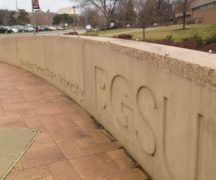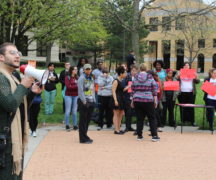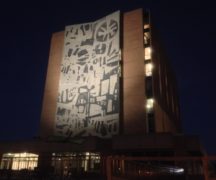By DAVID DUPONT
BG Independent News
A plan to bring a company to campus to locate on the site of the Forrest Creason Golf Course is in the very earliest conceptual stage.
President Mary Ellen Mazey said that the idea to attract a company, possibly a high tech firm, was at this point little more than a talking point.
She did broach the concept recently at a luncheon meeting when university retirees when asked about the future of the golf course.
She said she’s also discussed it with a number of alumni.
Her interest was piqued during a chat with one alumni Mick Story, who works for Jackson National Life. Story, a former Falcon football player, said that Jackson Life located near the Michigan State University campus to have proximity to its future workforce.
Such an arrangement could also fit in with the state’s Third Frontier initiative which seeks to develop high tech industry in Ohio.
The company could provide internships to students.
Mazey noted that the university has a strong program in supply chain management. It also has a record of successful collaboration with outside entities, including the Falcon Health Center, the Falcon Flight Center, and the Bureau of Criminal Investigation lab.
But any corporate project is still very much in the conceptual phase. For any property to be leased or sold, the BGSU Board of Trustees would have to take action.
While the future use of the 138–acre golf course is what initiated this line of thinking, the university also has other property it could develop, on both the west and east side of I-75 and to the north across East Poe Road. It also has a parcel to the west that was once part of the Heinz complex.
Mazey reiterated the reasoning behind closing the golf course. Students are not on campus during most of the golf season, and millennials have less interest in the sport than their elders.
She said the university took a long hard look at the possibility of saving the course. She and her two sons played rounds on the course to see what could be done.
Arthur Hills, an internationally recognized golf course designer, even volunteered his services to come up with a plan. Though he worked for free, the concept he proposed would have cost $5 million to $8 million to realize. The problem, Mazey said, is that after years of neglect the infrastructure, including the club house and irrigation system, needs extensive investment.
When the decision to close the course was announced last spring, the university said it had lost $120,000 in 2016 operating the course. The number of rounds played has also declined.
In the end, she said, there was no option but to close it.
Forrest Creason was built in 1965 as a nine-hole course, then expanded in 1972. It was the university’s second course. A nine-hole course was constructed in 1946 in the area now occupied by Kreisher and Harshman.
Other plans that have been posited included housing development, possibly aimed at alumni. That was ruled out given the proximity to the city’s waste treatment plant and its odors.
Using it as a forest area was also mentioned last spring.
Nothing will be done, Mazey said, until the university has been able to develop firm plans.
In the meantime, the course will take some time to close.





